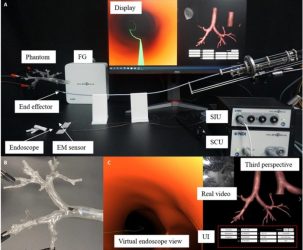Novel robotic bronchoscope system can help catch lung cancer earlier
Posted: 18 April 2023 | Izzy Wood (Drug Target Review) | No comments yet
Researchers from China have formulated a robotics system that can access areas in the lung non-invasively before cancer diagnosis.

Scientists from the Beijing Institute of Technology, China, have devised a novel robotic bronchoscope system that can non-intrusively access the area of interest within the lung for minimally invasive pulmonary lesions sampling, when diagnosing lung cancer.
According to the World Cancer Research Fund International, lung cancer was the second most common cancer around the world in 2020, with more than 2.2 million new cases and 1.8 million deaths.
However, lung cancer, like other cancers, is easier to treat if caught earlier. The new robotic system is believed to be the gold standard of lung cancer diagnoses. This research was published in Cyborg and Bionic Systems.
“Imagine inserting a long thin line into your mouth, through your airway to cut a little part of the lesion of interest within your lung. After that, this thin line brings the cut sample back for further examination to determine whether it’s benign or malignant.” said Xingguang Duan, a scientist from the School of Medical Technology, Beijing Institute of Technology.
“This is what the bronchoscope system was designed for. Our end effector is just like a thin line. To do so, this line must first be thin enough to cross the trachea and bronchus.”
“Moreover, it must be able to bend, rotate and translate to flexibly navigate the complex airway network.” explained Changsheng Li, the corresponding author of this research, from School of Mechatronical Engineering, Beijing Institute of Technology.

Roboticists from Beijing Institute of Technology proposed a robotic bronchoscope system aiming for the biopsy of pulmonary lesions
(Credit: Cyborg and Bionic System)
“To accurately approach the lesion of interest, the position and pose of the end effector must be determined in real-time.” added the authors. They addressed this problem by developing a navigation system, which attaches an endoscope and two electromagnetic sensors to the end effector, which enables online positioning for navigation and provides visual information for doctors to sample from.
The navigation system also reconstructs a three-dimensional virtual model based on computed tomography for robotic path planning, provided with the choice of the target area. Combining the flexible end effector and the navigation system, the robotic bronchoscope system can automatically reach the target lesion and provide intraoperative visual guidance for biopsy sampling.
They verified the feasibility of this robotic bronchoscope system via an ex vivo navigation-assisted intervention experiment. “During the experiment, the position displayed by the third perspective of the virtual endoscope is consistent with the position of the end effector’s tip relative to the airway phantom from visual observation. The virtual endoscope view also matches with the real video acquired by the endoscope module as expected,” described Li.
“Although the system has achieved promising bronchoscopy performance, as a medical device, there are still some issues that limit the clinical application and promotion,” explained the authors, “First of all, the more convenient manoeuvre is required for surgeons to readily learn and use. Secondly, high-resolution endoscopic view is required; and finally, the calibration between virtual and actual environments is still time-consuming and unfriendly to the novice.”
In the future, they will focus on minimising the diameter of the end effector and adopting replaceable modules for diverse surgical requirements, exploring joint control to allow the robot a more flexible movement in the airway, and adopting computer vision algorithms to realise automatic and intelligent calibration.
Related topics
3D printing, Ex Vivo, Lab Automation, Oncology, Robotics
Related conditions
Lung cancer
Related organisations
Beijing Institute of Technology
Related people
Changsheng Li, Xingguang Duan







